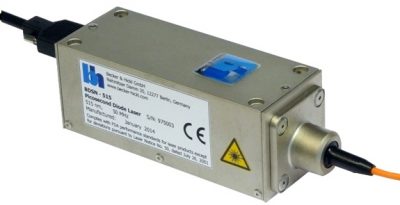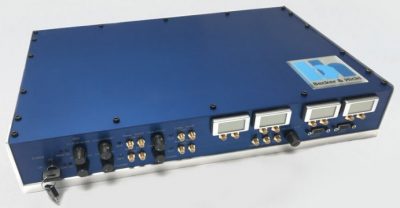About Picosecond Diode Lasers
Table of Contents:
- Principle of a Laser Diode
- Optical Properties of Laser Diodes
- Picosecond Diode Lasers
- Single-Mode and Multi-Mode Diode Lasers
- Peak Power
- Dependence of the Optical Pulse Shape on the Output Power
- Power Stability
- Timing Stability
- Pulse Repetition Rate
- Multiplexing Capability
- ‘Laser Hub’ with four Lasers of Different Wavelength
- Compatibility with bh TCSPC and TCSPC FLIM Devices
- Frequent Applications of the bh Picosecond Diode Lasers
Principle of a Laser Diode
Laser diodes are semiconductor diodes in which the recombination of electrons and holes in the p-n junction generates light. When the diode is pumped by a sufficiently high electrical current stimulated emission can occur. The junction is designed to form a wave guide, and reflective coatings at both ends form an optical cavity. When the amplification by stimulated emission exceeds the loss in the cavity laser action occurs.

Optical Properties of Laser Diodes
The beam geometry of a laser diode is far from ideal. Different than in other lasers, laser emission from a laser diode occurs in a relatively wide cone of light. This is due to the short length of the cavity and the diffraction in the small aperture of the device. To obtain a parallel beam of light a collimator has to be placed in front of the diode. However, even then the beam remains elliptical, and contains a noticeable amount of astigmatism. Focusing such a beam into a diffraction-limited spot is difficult. High-performance diode lasers therefore contain correction optics. The bh ps diode lasers use cylinder lenses which make the beam circular and simultaneously correct the astigmatism.
Picosecond Diode Lasers
Picosecond diode lasers use laser diodes that are driven by fast electrical pulses of high current. If the pulses are sufficiently steep the diode is emitting extremely short optical pulses. The optical pulse width can be shorter than the width of the electrical pulses. In practice, the driving pulses have a width on the order of a few 100 ps. The width of optical pulses is on the order of 30 ps to 100 ps. How fast it is depends on the electrical properties of the diode, especially the junction capacity and the internal serial resistance, the shape and amplitude of the driving pulse, and on the optical properties, such as the gain in the cavity.

Single-Mode and Multi-Mode Diode Lasers
Single-mode laser diodes excite only a single transverse mode in the cavity. Apart from the aberrations mentioned above, the light virtually comes from a single spot inside the laser diode. That means the light can be projected in a single-mode fibre or in a diffraction-limited spot in a laser scanning microscope. The downside is that the optical power is relatively low – typically 100 mW in the CW mode and a few mW in the picosecond mode. This may sound not very much but, in fact, the power obtained from BDS-SM single-mode lasers is absolutely sufficient for single-molecule, fluorescence-decay and FLIM or FLIM / PLIM measurements.
Higher power is obtained from multi-mode lasers. Multi-mode lasers excite more than one transversal mode. Virtually, the light does not come from a single spot but from a line inside the diode. Multi-mode diodes (and diode lasers based on them) therefore cannot be used to focus the laser light into a single mode fibre, or to obtain diffraction-limited resolution in a laser microscope. The power of the bh BDS-MM multimode lasers can be up a few 10 mW in the picosecond mode. This is a benefit for measurements of diffuse optical tomography. High power is beneficial in this application, and diffraction-limited focusing and focusing into single-mode fibres is not needed.
Peak Power
The peak power a picosecond diode laser can deliver is limited by the stability of the semiconductor material and the reflective coatings. Typically, the peak power of the output pulses cannot exceed 10 to 20 times the maximum CW power the diode is specified for. When this power is exceeded the emission either saturates or the laser diode is damaged.
Dependence of the Optical Pulse Shape on the Output Power
The shape of the optical pulses changes with the driving power. At a driving power close the laser threshold the output pulses are relatively wide. With increasing driving power the pulses get narrower. At high driving power the pulses develop tails or afterpulses, see figure below. In applications where the pulse width is important, such as fluorescence lifetime measurement or FLIM, the laser should therefore be operated at a driving power close to the optimum pulse shape, and the optical power be adjusted by an optical attenuator.

Power Stability
Without external stabilisation, the optical power of laser diodes is anything but stable. The optical power critically depends on the electrical driving power, on the temperature, and, in ps diode lasers, on the shape of the driving pulses. When operated in the CW mode, several longitudinal cavity modes are competing, resulting in random fluctuations of the output power. The bh ps diode lasers therefore have an internal power stabilisation function. A small part of the optical power is diverted into a photodiode, the output current of the photodiode is compared with a reference signal, and the driving power is regulated so that the optical power matches the equivalent of the reference signal. As a result, the output power remains constant even under extreme conditions, for example in the first minutes after the laser has been turned on, or when the laser is on / off modulated for PLIM operation or wavelength multiplexing.
Timing Stability
Timing stability, i.e. stability of the temporal location of the optical pulse referred to the electric reference output pulse, is of paramount importance in all time-resolved recording tasks. For example, a shift of the optical pulse in time is transferred to a shift of the same size in a measured fluorescence decay time. bh lasers are therefore designed to provide extraordinarily high timing stability. Typically, the timing stability is better than a few picoseconds even immediately after turning on the laser.
Pulse Repetition Rate
The repetition rate of a ps diode laser depends on the repetition rate of the driving generator. Apart from thermal considerations there is little limitation by the laser diode itself. At the high end, the repetition rate can be as high as 100 MHz. At the low end, the repletion rate can be arbitrarily low. It should, however, be noted that the peak power is limited to a few 100 mW. The average power therefore decreases with decreasing repetition rate. Moreover, stabilisation of the output power (see above) becomes difficult. It is therefore not recommended to design experiments that run at pulse repetition rates below 5 MHz. Please consider the bh PLIM technique for such experiments.
Multiplexing Capability
All bh picosecond diode lasers can be multiplexed in time. Multiplexing is used when a measurement of a laser induced effect is to be performed at several laser wavelengths simultaneously. Using the fast on/off capability of the lasers multiplexing can be performed down to the lower microsecond range. The multiplexing function is control by the GVD-120 or GVD-140 scan controller and synchronised with multi-dimensional TCSPC or TCSPC/FLIM recording via the routing signals of the bh TCSPC modules.
‘Laser Hub’ with four Lasers of Different Wavelengths
The use of several lasers of different wavelength is greatly simplified by the bh ‘Laser Hub’. The output beams of four BDS-SM lasers are injected in one single-mode fibre and delivered to a measurement device by this fibre. The lasers can be controlled individually in power, turned on and off individually, and multiplexed by fast on / off signals from the GVD-140 scan controller.

Compatibility with bh TCSPC and TCSPC FLIM Devices
The BDS-SM and BDS-MM picosecond diode lasers are a perfect match for the bh TCSPC and TCSPC FLIM devices. The trigger output of the lasers is directly compatible with the SYNC input of the TCSPC / FLIM modules. Direct on/off and power control from the bh GVD-120 and GVD-140 scan controllers provide direct integration in bh TCSPC FLIM systems, with intensity control from the acquisition software, beam blanking, laser multiplexing, and simultaneous FLIM/PLIM functions. High repetition rate avoids pile-up errors and helps achieve short acquisition time. Repetition rates in the range from 50 to 80 MHz, as they are routinely available in bh ps diode lasers, are a good compromise between pile-up and incomplete decay of fluorescence-decay signals. High power stability and high timing stability allows the user to perform quantitative fluorescence-decay and FLIM measurements and run FCS measurements free of artefacts from laser power fluctuations. The CW mode integrated in the BDS-SM provides excitation for ‘full correlation‘ measurements from the picosecond to the millisecond range. In experiments of diffuse optical tomography the BDS-MM lasers provide power to obtain short acquisition times, and the ability to multiplex several lasers of different wavelength.
Frequent Applications of the bh Picosecond Diode Lasers
Due to their short pulse width, extraordinarily high timing stability, power stability, fast on/off and multiplexing capability, and easy integration into bh TCSPC systems the BDS-SM and BDS-MM lasers are routinely used in a wide variety of biomedical applications. Examples are FLIM microscopy, molecular imaging, FLIM FRET, FLIM of macroscopic objects, metabolic FLIM, FCS, single-molecule spectroscopy, ophthalmic FLIM, and NIRS and fNIRS of thick tissue.
Picosecond-Diode Lasers for Time-Resolved Spectroscopy

Designed and manufactured by Becker & Hickl – High Performance picosecond diode lasers with wavelengths from the NUV to the NIR. All bh pulsed diode lasers work with simple +12V power supply or pull their power from the USB port of a PC or Notebook Computer. Other features are high repetition rate, short pulse width, unprecedented timing and power stability, and extremely low electrical noise level. The complete driver electronics is integrated in the laser module. All bh diode laser modules are directly compatible with the bh TCSPC modules. On this page, learn more on the various applications of our product, especially in TCSPC systems. Choose your ps laser now:
| BDS-SM Series | BDS-SMY Series | BDS-MM Series | UVL-FB Series | ||
| Interface |
USB 3.0 |
analog / |
analog / digital |
analog / digital |
analog / digital |
| Wavelength / nm |
375 to 785 |
375 to 1064
|
532, 561, 594 | 405 to 915 | 270, 310 |
| Pulse Width Range (FWHM) / ps |
30 – 90 (Medium Power) |
30 – 90 (Medium Power) |
40 – 80 |
65 – 120 (Medium Power) |
typ. 580 (Medium Power) |
|
60 – 300 (Max. Power) |
60 – 300 (Max. Power) |
– |
120 – 300 (Max. |
typ. 700 |
|
| Repetition Rates / MHz | 20, 50 and 80 |
20, 50, 80 and CW, Other on Request |
20 or 50, Other on Request |
20 and 50, Other on Request |
20, 50, 80 |
| Average Power, mW | 3 – 5 @ 80 MHz |
3 – 5 @ 80 MHz |
0.3 – 1 @ 50 MHz |
10 – 40 @ 50 MHz |
0.06 |
| Peak Power / mW | 100 to 1000 | 100 to 1000 | 100 to 250 | 1000 to 5000 | up to 1 |

